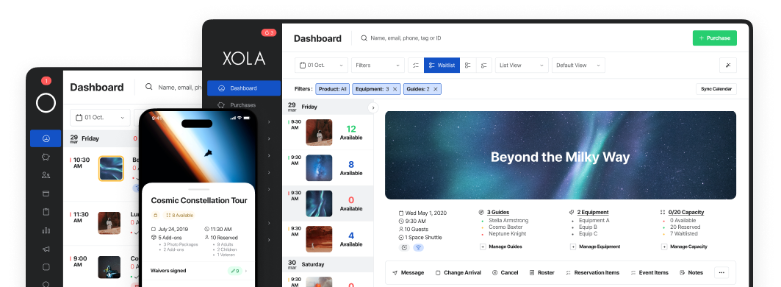
Thousands of businesses rely on a comprehensive booking management tool to streamline operations and enhance customer experience every day.
With so many options available, it can be overwhelming to choose the right software for your business.
In this post, we’re looking at the best tour booking software for tours and attractions — and sharing eight essential features to look for before making your choice.
- What is tour booking software?
- What are some examples of tour booking software?
- When to create a DIY tour booking system
- When to use online tour booking software
- Key features for online booking software
- What to look for when choosing tour booking software
- Manage your online bookings with Xola
What is tour booking software?
Tour booking software makes it easy to accept online bookings through your website. It’s an omni-channel booking system that helps tour and activity businesses manage all booking activities, including customer relationship management (CRM), secure online payments, equipment, guides/staffing, and availability.
Rather than manually keeping track of every new reservation, tour booking software stores the information for you. It automatically updates tour and guide availability accordingly and sends automatic confirmation emails (as well as followup emails) to guests after they book.
What are some examples of tour booking software?
Managing your bookings and processing payments through your website can take a lot of time, especially when your booking volume starts to increase. Fortunately, these booking solutions can free you from the hassle of manual bookings.
Xola is one of the best examples of online booking software for tour and activity businesses. With its user-friendly interface and robust features, Xola has become a popular choice for tour companies looking to grow their business, streamline their booking process, and improve their overall efficiency.
When to create a DIY tour booking system
Every successful travel company needs an online reservation system. When you first start your business, you might use a free online booking form before investing in a more sophisticated program. You can, for instance, create a DIY booking form with a WordPress free form plugin or Google Forms and embed it on your site.
Let’s explore the pros and cons of DIY booking forms to find out if this is the best option for your tour company.
Pros of using a DIY tour booking system
- It helps keep your starting costs low. Most DIY booking forms are free to use.
- It can help you learn about your booking needs, which will help you invest in the right software in the future.
- Guests can book directly with you through your website.
Cons of using a DIY tour booking system
- You have to manually manage everything. You’ll need to carefully track the booking process from start to finish, which can include manually processing payments, scheduling tour guides, and sending individual confirmation emails.
- Most online free booking forms don’t have payment processing features. You’ll likely need to find a third-party solution that’s secure enough to store guest credit card information or, alternatively, accept cash payments.
- You’ll need to keep track of tour and guide availability on your own, which increases the risk of overbooking.
- You’ll need to store customer information like names, phone numbers, and emails and ensure everything is accurately updated on the guest rosters sent to guides.
- When your bookings start to increase, overbookings are more prone to happen.
When to use online tour booking software
Over 60% of leisure travelers in the U.S. find flights, accommodations, and travel experiences online. When one of these travelers lands on your website, they may be ready to book tours.
An easy-to-navigate brandable booking website can help you turn these visitors into paying customers.
When you are first getting started as a tour or activity provider, you may only have a handful of travel bookings. However, there will come a time when your DIY booking form is no longer getting the job done. As your marketing starts to take off, your booking volume will increase.
You’ll soon realize that managing a higher volume of bookings and all related business operations requires a lot more time and effort to avoid overbooking or getting negative customer feedback.
That’s when it makes sense to transition from DIY manual bookings to designated tour reservation software.
Pros of booking software
- Automation saves you a lot of time. Everything from the confirmation email to the tour availability shown on your website will be automatically managed by the software.
- Every booking is processed in real-time, ensuring your tour availability is always accurate.
- Your website gains a smooth and secure online checkout allowing guests to pay directly on your website.
- It’s easier to enforce cancellation or no-show fees now that customers’ credit card information is securely stored with your booking software.
- You gain access to valuable revenue and business intelligence reports.
- Some software come with scheduling features that allow you to manage your guide schedules and equipment based on your booking volume.
Cons of booking software
- It requires an investment. New operators may not feel ready to take on that extra cost.
- Not all booking software is created equally. You need to understand your tour company’s booking needs to be able to choose the right one.
- You need to at least a half dozen bookings to justify the setup time and extra costs.
Key features for online booking software
When considering an award-winning booking system, here are some features you should look for it. In addition, you’ll want to make sure the solution works well with your complete booking management system.
Online Checkout
Robust B2C booking platforms should include a conversion-optimized booking flow that displays real-time availability and processes secure payments seamlessly. You’ll also want to evaluate and compare the fees on bookings (and whether or not you want to pass the fees to customers.)
Marketing & Growth Features
With automated growth features like Xola’s Abandoned Booking Recovery, Lightning Deals, and options for upsells and cross-sells, travel operators can efficiently boost the number of bookings. These marketing tools are designed to enhance operational efficiency and increase direct bookings for tours and experiences.
OTAs & Distribution
You’ll also want to make sure that your booking software integrates with your key third-party distribution network sources. This may include all of the major online travel agencies (i.e. OTAs) such as Tripadvisor and GetYourGuide, along with destination management companies, travel agencies, affiliates network, and other third-party distribution channels. Having strong distribution capabilities streamlines the promotion and management of your offerings across multiple sales channels, helping to attract new customers and maximize bookings.
Digital Waivers
Incorporate online waivers to streamline the check-in process. This built-in functionality, which is free in Xola, allows guests to securely complete waivers before arrival, speeding up the check-in process and reducing administrative tasks for your team. Digital waivers also collect valuable customer data, which can be used in marketing efforts to attract additional guests.
Xola also enables the attachment of customer questionnaires to waivers, gathering further details for customized experiences that enhance guest satisfaction and encourage positive reviews.
Reporting
Your booking software should provide detailed sales reports, showing bookings across various channels, and delve deeper into customer data, marketing effectiveness, and resource utilization. This is crucial for making informed decisions that drive future growth.
POS + Ticketing
These features, like waitlists, ticketing, POS, and virtual queues, can help you manage high volumes of walk-in customers. This ensures quick and smooth activity reservation processing, improving the guest experience by reducing wait times and facilitating organized entries during peak periods.
Guide & Equipment Management
Your software should offer a centralized platform for scheduling guides and equipment, task delegation, and communication, boosting operational efficiency and maintaining high service standards.
Tour & Booking Management
Online booking engine providers also provide tour and activity operators with the tools to customize every aspect of their services, from scheduling to pricing, with unparalleled ease. Such flexibility is essential for meeting diverse customer needs and ensuring smooth operations.
Customer Management
Your booking system should facilitate detailed tracking of customer interactions and preferences, enabling personalized marketing and service offerings that lead to superior customer service, more positive reviews, and increased bookings.
What to look for when choosing tour booking software
Every operator will eventually feel ready to upgrade from their DIY booking forms. Here are eight features to look for when shopping around for your booking software:
1. Thorough and easy onboarding
Setting up new software can be overwhelming. If you do something wrong, your site could crash or lose its user-friendliness. You should look for a software company that walks you through the integration process and thoroughly explains how to operate the system. Xola, for example, can integrate with your website in just a few seconds with its booking widget. A dedicated account manager will help ensure everything is functioning the way it should, and will be on call if anything goes wrong. Xola ensures a thorough and easy onboarding process so that your site can be up and running more efficiently in no time.
2. Intuitive and easy to use
Will your tour operator software lead to a more enhanced reservation flow for both your customers and team? They should exert little to no effort to make a booking on your website. For example, when customers book, they should never have to look for a “book now” button. It should clearly stand out from your site.
The software should also be intuitive for you and your staff to use on the back-end. Every time you onboard a new employee, they’ll need to learn how to use the system. Make sure it’s easy to train new and existing staff so that you don’t wind up with an overly complex system.
3. Optimized for mobile
When travelers book experiences on the go, they’re probably doing it on their smartphones. Make sure your booking software is optimized for mobile bookings so you can capture these reservations.
4. A secure checkout
Not only should your checkout page load quickly and be easy to fill out, but it should also look professional. A clean and modern checkout will make the customer feel comfortable with sharing their personal information. Credit card information should also be securely stored.
4. Automations
One of the prime benefits of investing in booking software is that it will automate much of the process for you. Previously tedious tasks like sending confirmation emails and reminder texts can now be automated.
5. Integrations
Make a list of the tools you already use to manage your business, such as your email newsletter provider, accounting program, and calendar. Now check if the booking software integrates with those apps. Ideally, your booking software will be in sync with all of your existing apps. You can then manage most of your operations on a single dashboard.
6. Revenue reporting
Operators gain access to a wide range of financial reports — like a P&L statement, balance sheet, and cash flow statement — that help them make smarter business decisions. Make sure to check what kind of revenue reports and BI tools the software offers. Xola, for example, helps identify your most valuable listings and booking channels, assists in capacity planning, and tracks customer satisfaction scores.
7. Marketing features
Does the software offer any marketing support? Features like automated guest review emails, abandoned booking emails, and seasonal pricing can take your marketing strategy to another level.
8. 24/7 customer support
Your booking platform should feel like a business partner that’s always there to support you. If something goes wrong, you want to be able to reach out to them as soon as possible, even if it’s after business hours.
Manage your online bookings with Xola
See why the leading tour and activity operators choose Xola to drive growth, process payments, and manage their online booking experiences. Ready to learn more about our powerful software? Request a free demo here.





